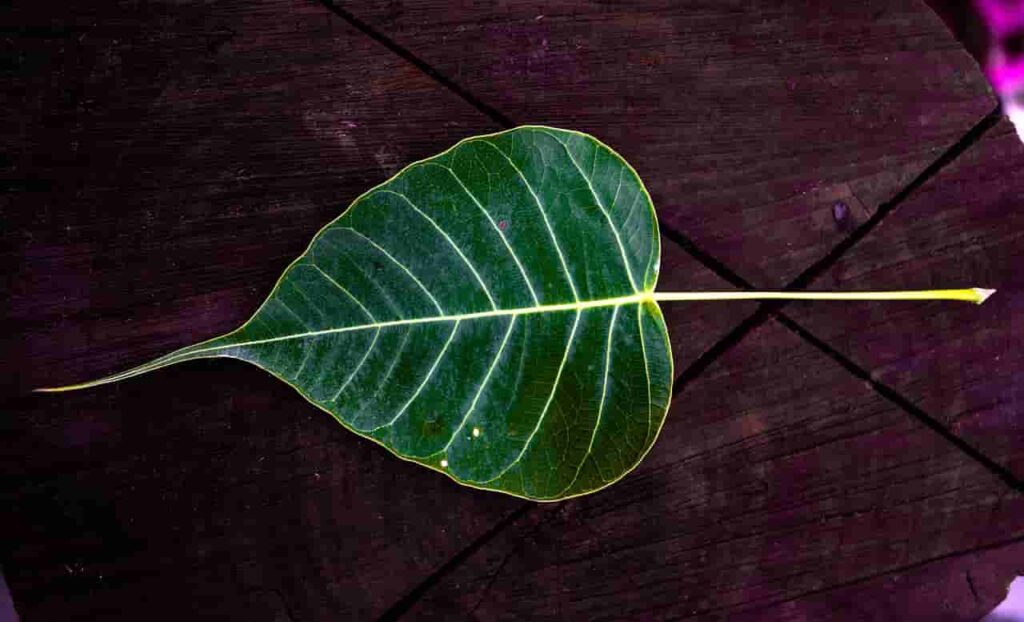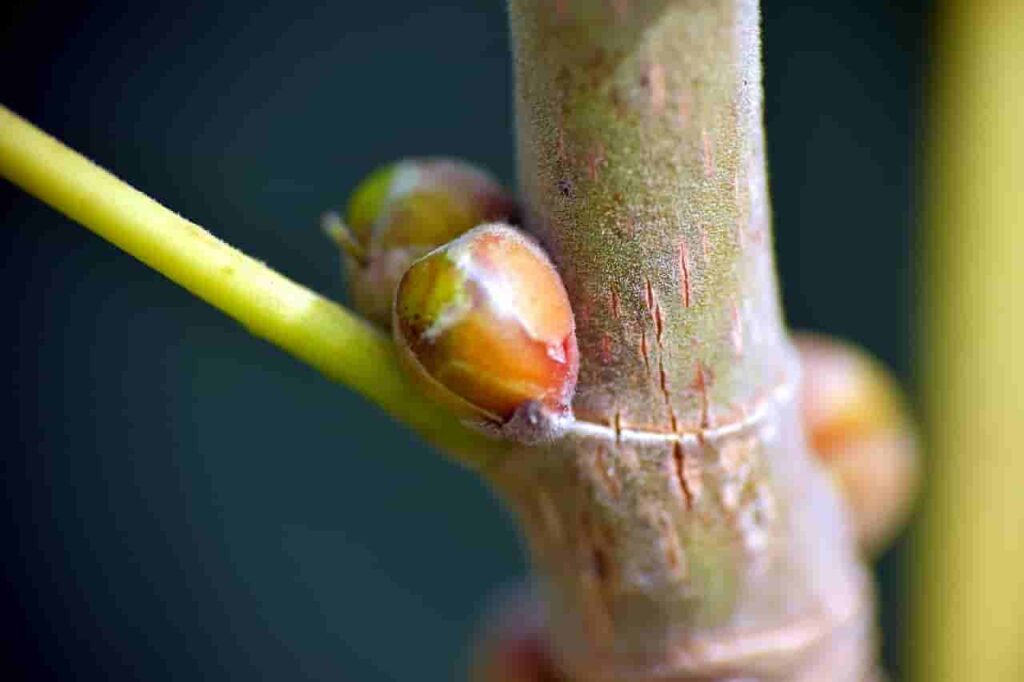Peepal Tree or Ficus Religiosa is commonly known as Sacred Fig in English. Peepal is the Hindi name of Ficus Religiosa. Peepal tree is native to the Indian subcontinent and regions around this area. It is mainly a warm climate tree. Peepal tree is also known as Bodhi Tree, Bo Tree, Pippala Tree, Piplo, Jari, Piparo, Pipalo, Peepul Tree, Pimpal, Pippal, Pipal Tree, Buddha Tree, Ashwattha Tree, Ashwarthan, Arasamaram, Arasan, Arasu, Arara etc. It belongs to the fig family of plants. It is of the plant genus Ficus (Moraceae).
Peepal or Ficus Religiosa is considered holy in some religions like Hinduism, Jainism & Buddhism. It is worshipped by many in these religions.
It is believed that Gautam Buddha was enlightened under a Peepal Tree. Hence many people follow the same practice and meditate under Peepal Tree. Therefore this tree was named Bodhi Tree.
Ficus Religiosa grows abundantly in countries like India, Bangladesh, Pakistan, Nepal, Thailand, Myanmar, Malaysia, etc. Peepal Tree is a tropical tree and needs a warm climate and full sun to grow. They are also grown in Iran, Venezuala & Florida nowadays.
Sacred fig likes dry climate. It is a deciduous/semi-evergreen tree known for its spread and grand structure it takes when fully mature.
Ficus Religiosa is the scientific name of the Peepal Tree.
Contents
Peepal Tree Classification
The peepal tree has been classified as an environmental weed with a very high invasive score. It is highly invasive because it adapts to various types of soil conditions, temperatures, altitudes, etc., and can grow almost everywhere if not controlled. The growth rate of Ficus Religiosa is high and therefore they develop and spread very quickly.
Peepal tree does not have any aerial roots unlike Banyan tree.
Soil & Growth Conditions
Sacred Fig grows well in sandy loam soil which is well-drained although it can grow in a wide variety of soils. If you live in a tropical region, you must have seen Peepal trees growing in the crevices of the floors or roofs or rocks.
They prefer soil with having a pH below 7. They can be grown indoors but they are essentially outdoor plants by nature.
Temperature Requirement for Ficus Religiosa
Peepal trees require a temperature between 0 degrees C to 36 degrees C to grow optimally. They survive in extreme climates however the growth reduces or is stunted in those conditions. In India, it grows at an altitude of up to 1,520 m (4,990 ft).
Sacred Fig likes hot & humid climatic conditions.
Peepal Tree Leaf
The leaves of Sacred Fig or Ficus Religiosa are heart-shaped with a dripping tip as shown in the image below.

A peepal tree leaf can be 11 to 17 cm long and 7 to 11 cm wide. When dry, the leaves leave behind a structure of the plant’s veins and plants cells. Each leaf has around 5-7 veins. This is used by many to make art and crafts.
Many people use them as drawing boards to create beautiful paintings.
Apart from artistic values, peepal tree leaf has many other uses and applications:
- They help to treat skin itching.
- For healing cracked heels.
- Treating skin acne and rashes.
- They are used to feed elephants and camels.
The newly developed leaves are pinkish-red in color. The tree partially shed its leaves in the autumn or during the November-December months.
They develop in a spiral structure and they are mostly ovate in shape.
Fruit of Peepal Tree / Bodhi Tree / Ficus Religiosa

The fruit of the peepal tree is a fig that is green in the initial stages of development. It turns purple-black in color when ripe. It is 1/2 inch in diameter, circular and compressed.
Peepal tree flowers in February & fruits in the month of May (in India) or in the summer season and ripes in the rainy season. The figs always grow in pairs. The new leaves appear in the month of April (India).
Ripe fruits of this tree are consumed to reduce burning sensation and to improve poor appetite.
The fig fruits are actually false fruits (multiple fruits) for the reason that they are an enclosure to multiple flowers and seeds growing together.
The flowers are pollinated by fig wasps who enter the fruit crevices in search of a suitable place to lay eggs.
The fruits are laxatives and latex is used as tonic.
The figs are eaten by birds as fodder.
The bark of Sacred Fig is greyish brown in color and peels off in the form of patches.
Peepal Tree Bonsai
Ficus Religiosa can be converted into a beautiful Bonsai over years. It attains a spectacular shape and structure when it becomes a mature bonsai. It gives you the feel of a forest or of the wild.
Watch this video to learn how you can make a bonsai of Peepal Tree plant.
Peepal Tree Lifespan
The average age of the peepal tree is between 900 to 1500 years. Ficus Religiosa has a very long lifespan. There are Sacred Figs that are known to be around 3000 years old (oldest trees in the world)
It is a perennial tree.
Height of Sacred Fig
Ficus Religiosa or Sacred Fig can grow up to a height of 30m (98 ft). The diameter of the trunk can grow up to 3m (9.8 ft) in width.
Propagation of Peepal Tree / Ficus Religiosa
Sacred figs can be grown by sowing seeds or by cuttings.
The seeds are normally scattered or dispersed by fruit eating birds and insects.
They shed their leaves in the months of March & April (in India) during the spring season
Benefits of Ficus Religiosa / Sacred Fig
Many of us would have heard this question “Does Peepal Tree release oxygen at night ?”. And the answer is YES.
Unlike many other trees, the Peepal tree gives oxygen at night.
It is planted as a roadside tree and for avenue plantation for the broad canopy and shade that it provides.
Roots of Peepal Tree
The roots of the Peepal Tree penetrate the soil very deep. Peepal tree is an Epiphyte. It has a smothering growth when grown with other plants. However, it is not a parasite. It does not starve the host plant. It takes nutrition from air and rainfall untill the roots develop and reach the ground.
The roots fuse with stem to form a thick stem system.
The roots gradually cover the host system where it grows and hence is is named strangler fig.
Peepal Tree Significance
Sacred fig is a symbol of the never-ending expanse of the universe and is hence revered in Hindu culture. For the same reason, it is known as the Tree Of Life.
In Buddhism, Peepal Tree is treated as a personification of Buddha and hence the leaves of this tree are used for religious purposes.
Peepal Tree is a symbol of enlightenment and peace for many.
Hindus believe it is the tree below which Lord Vishnu was born.
Ficus Religiosa is also a symbol of fertility. Hence it is worshipped by women in Indian villages.
Because of its sacred nature, it is normally planted in Hindu temple premises.
Peepal Tree Plantation
A man famously known as ” Peepal Baba” has planted over 1.25 cr Peepal trees in India and over 20 million trees in total.
Since there are religious sentiments attached to a Peepal plant, people normally do not uproot them. This provides them natural protection from being cut down by human beings.
You can take any stray plant from the roof or walls and plant them in pots.
Germination from seeds take time. The fig fruit wall is normally ingested by birds and animals and the seeds are then excreted out of the digestive system of these animals and birds when they get activated and germinate. The fruit wall of fig is very hard and hence does not easily germinate when planted directly in soil.
Can We Keep Peepal Tree At Home?
Many consider Peepal Tree as bad as according to Vastu, they create hindrance in progress and bring day-to-day problems to the family.
However, there is a scientific reason for not growing this plant in homes. And that is because the roots of the Peepal tree penetrate the soil or the host structure very deeply. It can starve the surrounding trees or plants of essential nutrients.
Since the roots penetrate deep, they can weaken the foundation of the building or your house if allowed to grow uncontrolled.
Another reason is they grow really big and take a lot of space in your garden leaving a little room for other plants. Peepal tree forms a very big canopy of branches and leaves when mature therefore depriving the low-height plants and trees of required sunlight.
If you do not believe in Vastu Shastra, you can very well grow them in pots or make bonsai out of them as they look stunning when the tree is mature.
Herbicide
Glyphosate is used as a herbicide to contain or stop unwanted growth of Sacred fig on roofs and in floor crevices. It is sold under many names such as Accord, Glypro, Round up, etc.
Liquid Hydrogen Peroxide is also used to disintegrate the cell walls of Peepal plant and inhibit its growth.
You can also try sprinkling salt water around the root area of the plant to stop the growth.
Another method is to pour Kerosene.
A natural way is to pour sugar water around the roots and ants will take care of the rest.
You can try any of the above methods whichever works best for you.
Uses of Peepal Tree
Sacred fig has multiple uses and applications:
- It has many medicinal properties. It is used to treat a number of infections and inflammations like asthama, diabetes, snake bites, skin diseases, kidney diseases, etc.
- Sacred fig has many applications is Ayurveda stream of medicine.
- The leaves of Ficus Religiosa has Glucose, Mennos, Phenolic and Asteriod stored in them (medicinal uses).
- The bark of this tree has good amounts of vitamin K.
- Peepal tree fruit (fig) is used as a bead to revere Gods in Hindu temples.
- Peepal tree is cultivated to harvest its fruit.
- A reddish dye is extracted from the bark of Ficus Religiosa. Bark is used in tanning.
- It is used as Firewood.
Hope you enjoyed reading this article. If you like it, please hit the share button below.
If you would like to read more interesting articles, please read the following posts:
- Lucky Plants For Home: 12 Best Plants To Keep in Your Home
- Camellia Japonica / Japanese Camellia: Plant Care Tips & Guide
- Tulsi Plant Care: How To Grow Tulsi Plant Faster
- Mogra Flower: How to grow Jasminum Sambac at Home?






Leave a Reply